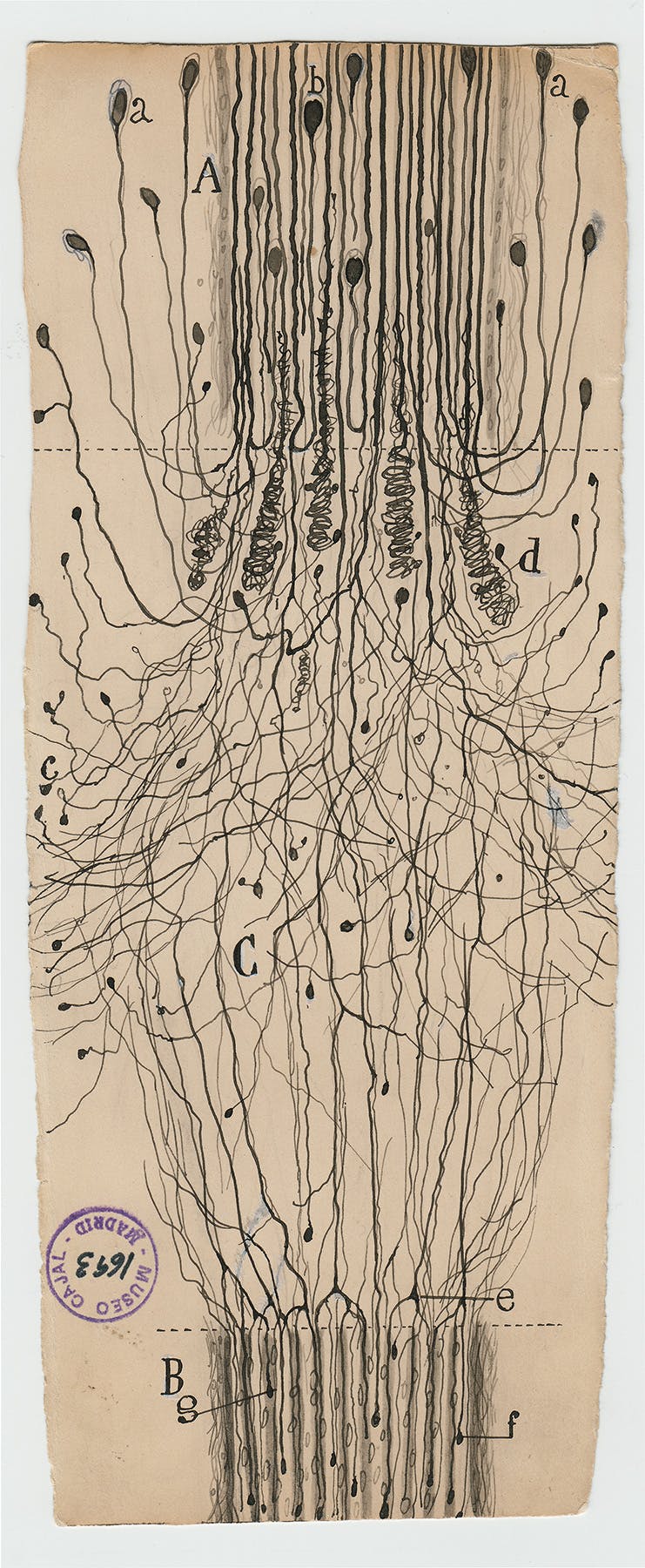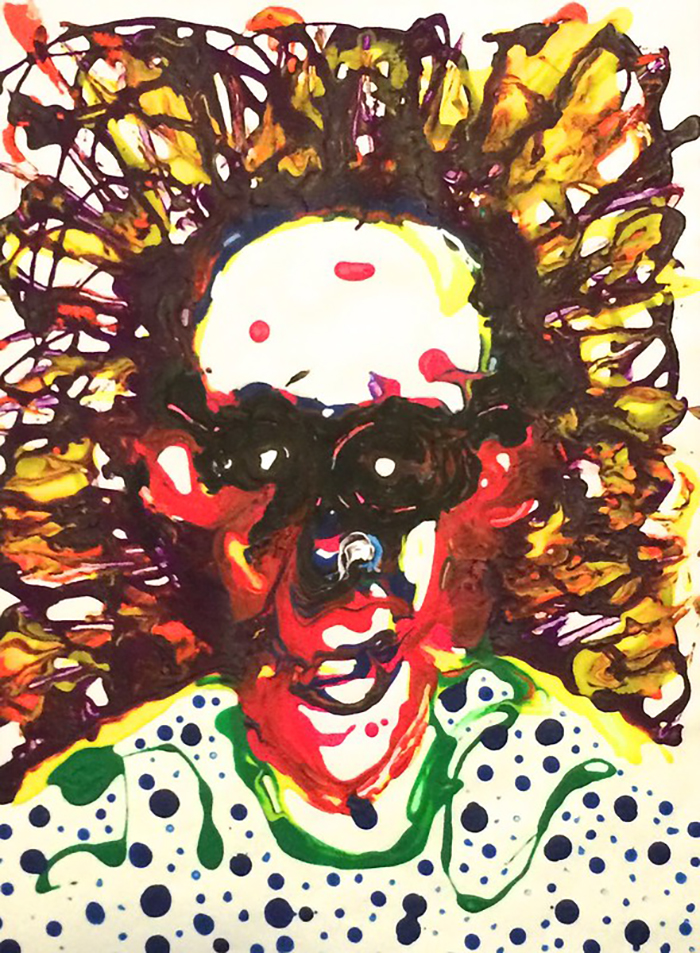Week 7 - Neuroscience and Art
As art has transversed into the realm of human physiology, some individuals have taken a step further and have begun to explore artistry within neuroscience. In fact, it is a fitting field because, as mentioned by Frazzetto and Anker, neuroscience holds the potential of revealing the sources of human individuality through emotion, consciousness, and overall cognitive processes by exploring the underpinnings of the mind -- indeed, this disclosure of human character and expression is a true pillar of art itself. Hence, when neuroscience is merged with artistry and commercial creation, these neurocultural projects hold the potential of not only demonstrating the beauty and aesthetic of the brain and its mechanisms but also relaying scientific discoveries and their social implications to the public domain (1). 
Ramón y Cajal's drawing of neurons within the nervous system
An example of an artist depicting the aesthetic of neuroscience and the human brain can be found in the work of Santiago Ramón y Cajal. Named the Father of Modern Neuroscience, Ramón y Cajal continuously used artistry to document his developments and observations in science. For example, he disproved contemporary notions such as the reticular theory, the idea that everything in the nervous system was a single continuous network, by utilizing Golgi stains that supported the existence of separate neurons that communicate with one another. Ultimately, his freehand drawings turned out to be more accurate than the microscopic image photographic tools that were available at that time (Halliday).
Moreover, another project that demonstrates the amalgamation of neuroscience and art was the creation of the Brainbow -- this made by utilizing a genetic cell-labeling technique where fluorescent proteins were inserted into neurons within the brain through recombination. As such, the fluorescent unique color profiles were used as a labeling mechanism, essentially serving as cellular identification tags. As such, this project had multiple purposes which were fulfilled by utilizing artistry, such as tracing axons through the nervous system, following individual cells during development, or analyzing cell lineage (Weissman and Pan). Thus, this is an example of utilizing the artistic field in order to not only attain a scientific discovery, but also to relay the information in a visually pleasing and easily digestible form.
 |
| An image of the Brainbow -- specifically, fluorescent dendrites of the hippocampus |
Finally, an interesting study of neuroscience can be found in research regarding the impact of LSD on the human brain. Indeed, LSD is a hallucinogenic or “psychedelic” that is capable of altering perception, thoughts, emotions, and can cause potent hallucinations. This drug, however, was made illegal as it can be easily abused and ultimately it was deemed to serve no medical purposes. Indeed, because LSD generates hallucinations and delusions, many users have unpredictable reactions and effects, some of which include shifts in their emotions, personality, and mood. As such, many artists have created pieces analyzing and simply observing the effects of such drugs on their human character and individual. For instance, Bryan Lewis Saunders' "Under the Influence" was a piece where he made a self-portrait of himself each day under the influence of mind-altering drugs, one of which was LSD. Ultimately, he did so in order to examine how the influence of drug intoxicants impacted his perception of self.

Saunders' self-portrait, created while under the influence of LSD
Overall, I believe that the intersection of neuroscience and art is an extremely important and beneficial tool for understanding the inner workings of the human mind and unraveling revolutionary discoveries regarding the brain. Its specific benefits lie in its ability to portray this information to not only scientists but also the general public in a completely understandable manner. Moreover, simply visualizing these discoveries enables artists to depict certain ideals by means of their artistic creations.
WORKS CITED
Frazzetto, Giovanni, and Suzanne Anker. “Neuroculture.” Nature Reviews Neuroscience, vol. 10, no. 11, Nov. 2009, pp. 815–821., doi:10.1038/nrn2736.
Halliday, Ayun. “Neurons as Art: See Beautiful Anatomy Drawings by the Father of Neuroscience, Santiago Ramón y Cajal.” Open Culture, 8 Apr. 2019, www.openculture.com/2019/04/beautiful-anatomy-drawings-by-the-father-of-neuroscience.html.
LSD Fast Facts, May 2003, www.justice.gov/archive/ndic/pubs4/4260/index.htm.
Saunders, Bryan Lewis. “Artist Takes A Different Drug Every Day And Draws A Self-Portrait Under The Influence, Suffers Brain Damage (30 Pics).” Bored Panda, Mar. 1995, www.boredpanda.com/self-portrait-art-on-drugs-bryan-lewis-saunders/.
Weissman, Tamily A, and Y Albert Pan. “Brainbow: New Resources and Emerging Biological Applications for Multicolor Genetic Labeling and Analysis.” Genetics, vol. 199, no. 2, 2 Feb. 2015, pp. 293–306., doi:10.1534/genetics.114.172510.
IMAGES
Ramon y Cajal, Santiago. “The Beautiful Merger of Art and Science That Inspired Generations of Neuroscientists.” Massive Science, 30 Nov. 2017, massivesci.com/articles/art-science-neuroscience-cajal/.
Saunders, Bryan Lewis. “Under the Influence.” Bryan Lewis Saunders, bryanlewissaunders.org/drugs/.
Weissman, Tamily. “Cell Picture Show.” CellPress, www.cell.com/pictureshow/brainbow.
Comments
Post a Comment